Home / Assigning Cahn-Ingold-Prelog (CIP) Priorities (2) – The Method of Dots
Stereochemistry and Chirality
Assigning Cahn-Ingold-Prelog (CIP) Priorities (2) – The Method of Dots
Last updated: December 10th, 2024 |
Cahn Ingold Prelog Priorities (2): Determining R/S On Rings, Chains, And More
In this post we’ll expand on the Cahn-Ingold-Prelog (CIP) rules and show how to assign R/S in some trickier cases that involve rings, multiple chiral centers, multiple bonds, and isotopes. We’ll see that the “method of dots” is extremely valuable for breaking ties in determining CIP priorities!

This post was co-authored with Matt Pierce of Organic Chemistry Solutions. Ask Matt about scheduling an online tutoring session here.
Table Of Contents
- Recap: Determining CIP Priorities In Straightforward Cases
- How Do We Assign CIP Priorities In Trickier Cases Involving Rings, Multiple Chiral Centers, Multiple Bonds, And Isotopes?
- Reminder: Cahn-Ingold-Prelog Priorities Are Determined At The First Point Of Difference
- Assigning CIP Priorities: An Application Of The “Method Of Dots”
- How Do We Determine R/S Configuration In Rings?
- Determining R/S Configuration In Rings: A Common “Trick Question”
- Assigning R/S Configurations To Molecules With Multiple Chiral Centers
- Assigning Cahn-Ingold-Prelog (CIP) Priorities With Multiple Bonds
- Expanding Out Multiple Bonds With “Phantom Atoms”
- Cahn-Ingold-Prelog Priorities With Isotopes
- Conclusion: Assigning R/S Configurations With “The Method Of Dots
- Notes
1. Recap: Determining CIP Priorities In Straightforward Cases
In our first post on the Cahn-Ingold-Prelog (CIP) Rules, we gave a broad overview of how to assign R or S to chiral centers in a molecule. We followed this up with a subsequent post on how to use the CIP rules to determine priorities in alkenes in order to determine whether they are E orZ.
As with most introductory posts, the examples chosen were pretty simple. It’s fairly straightforward to assign priorities in a molecule like the molecules below where the central carbon is attached to four atoms with different atomic weights. And as we discussed previously, once you learn the single swap rule, it’s easy enough to determine R/S in cases when the #4 priority substituent isn’t pointing behind the plane of the page.
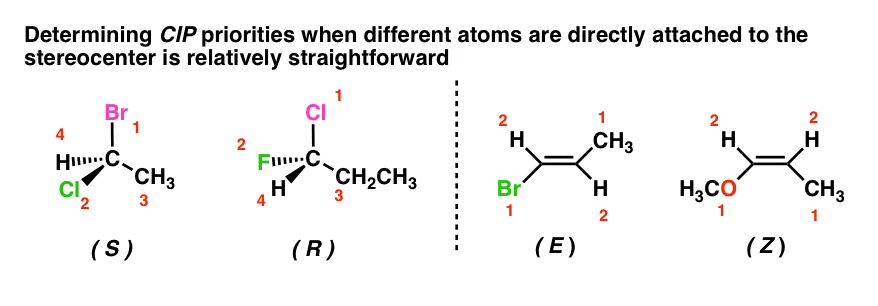
In cases of stereocenters which are attached to identical atoms, we saw that it’s also pretty straightforward to use the “method of dots” we used for E/Z configuration in alkenes to break ties and move down the chain. (See: The Method of Dots)
More on that in a minute: here are some exercises you can practice on if you like.
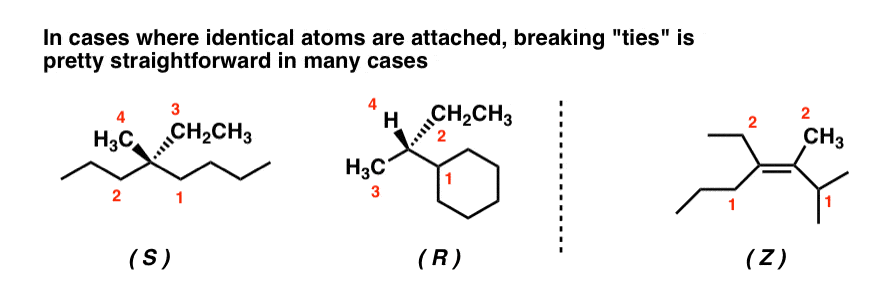
2. How Do We Assign CIP Priorities In Trickier Cases Involving Rings, Multiple Chiral Centers, Multiple Bonds, And Isotopes?
This post is about some of the further complications we see in assigning priorities. For example, how do you assign priorities in the following cases:
- Rings
- Multiple chiral centers
- Dealing with multiple bonds
- What about isotopes?
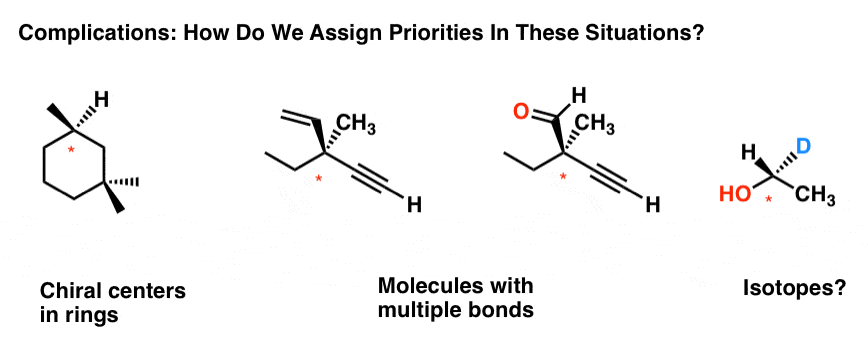
This post is devoted to sorting out these slightly trickier cases. We’ll focus exclusively on determining R/S but the same priority rules hold for determining (E/Z) as well.
3. Reminder: Cahn-Ingold-Prelog Priorities Are Determined At The First Point Of Difference
Let’s start with a common trick question. What’s the highest priority “group” attached to the chiral centre in the molecule below? Assign R/S .

Your first instinct might be to say, “the carbon chain containing the bromine”, since bromine has the highest atomic number of all the atoms in the molecule.
In fact, the carbon chain containing the bromine is the third priority group (only hydrogen is lower!), giving the chiral centre an R configuration.
This is because of the way that priorities are assigned: we move outward from the chiral centre, one carbon at a time, and determine priorities at the first point of difference.

 Click to Flip
Click to Flip
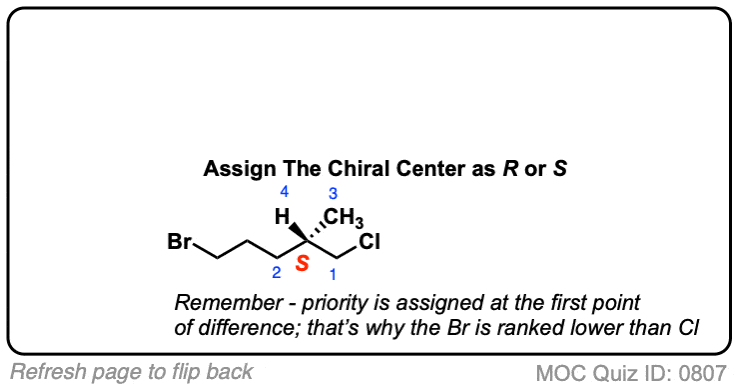
4. Assigning CIP Priorities: An Application Of The “Method Of Dots”
This process for assigning priorities here is essentially identical to what we showed previously:
- First, compare the four atoms directly bonded to the chiral carbon and rank them based on atomic number. In our example, H is clearly priority #4.
- If there is a tie, list all three atoms directly bonded to the tied atoms in decreasing order of atomic number. I find it helpful to put dots on each atom I am comparing, which is why I call this The Method of Dots).
- Compare each list, atom by atom. The t-butyl (C(CH3)3) group has the highest priority [C,C,C beats C,H,H]. but we still can’t differentiate the isobutyl group or bromopropyl group.
- Because there is still a tie, we move the dots one step further down the chain, specifically to the next carbon because that has the highest atomic number (the dots help us keep track of where we are). This now allows us to assign priorities #2 and #3 [C,C,H > C,H,H].
- With all priorities assigned, we’re ready to assign R and S by tracing the path of 1 → 3. Since #4 is on a wedge, the counterclockwise rotation signifies an R configuration (“opposite rule”).

If this is still unclear, hover here for a pop-up view or click on this link.
5. How Do We Determine R/S Configuration In Rings?
There’s actually no new rules required for determining priorities in rings, but many students tell me they have a hard time determining R/S if a chiral centre is on a ring. For this reason let’s go through an example and try to make this as clear as possible.
Determining R/S on a ring is just the method of dots all over again. We just move along the chain away from the chiral centre until we find a point of difference. Below, we have to move two carbons away from the chiral centre to prioritize (C,C,C) over (C,H,H):
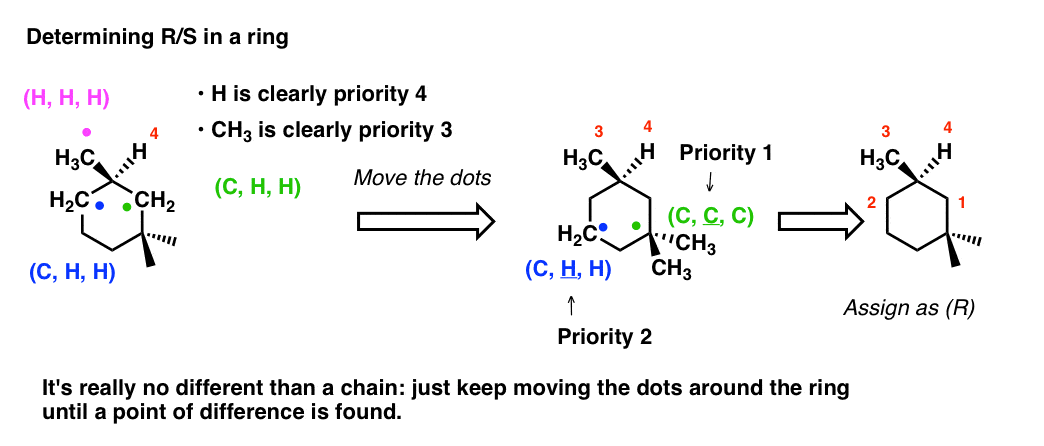
6. Determining R/S Configuration In Rings: A Common “Trick Question”
There actually is one case where determining R/S on a ring might seem weird to the uninitiated.
The molecule below has wedges and dashes indicating the stereochemistry of two carbons. What if you were asked to determine R/S for the starred carbon?
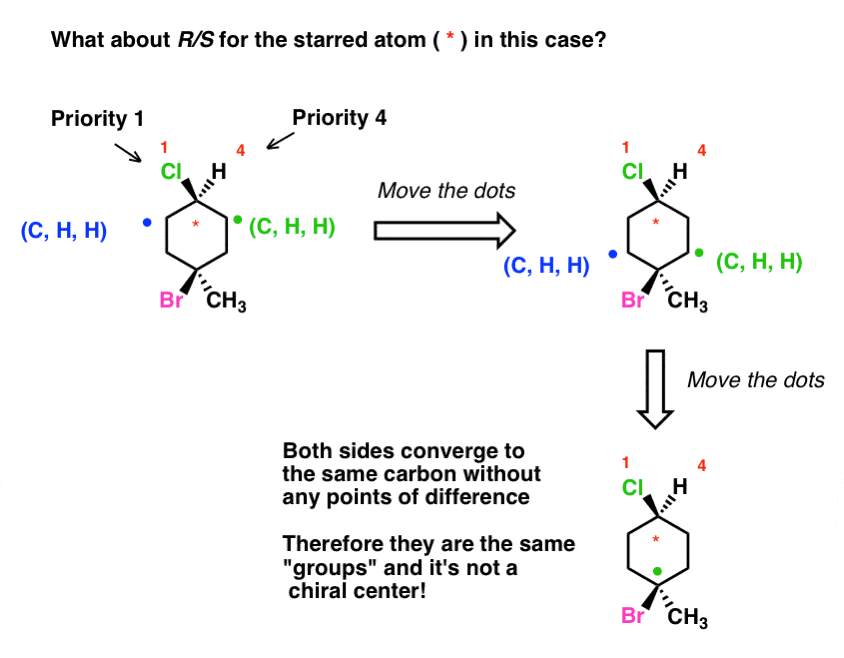
Hopefully you see that this is actually a “trick question”. When we try to determine a point of difference, we end up converging back to the bottom carbon without finding a single difference. What this means is that these two “groups” are actually the same and the “starred” carbon isn’t a chiral centre.
[One important point: although it may not be a chiral centre, it is a stereocenter. This disubstituted cyclohexane is capable of “cis-trans isomerism”, (aka “geometric isomerism”). If we invert the substituents on the carbon, we will end up with its stereoisomer. ]
7. Assigning R/S Configurations To Molecules With Multiple Chiral Centers
Molecules with multiple chiral centers don’t actually require any new concepts either. We merely have to identify each chiral centre and determine R or S for each. When we put together the final name, we then have to specify the configuration of each carbon at the beginning of the name.

Hence the molecule above is (1R, 3R, 4S)-3-bromo-4-ethyl-1-methyl-1-propylcyclopentane.
If you want to see exactly how the assignment for the (S) configuration was made, hover here for a pop-up view or click on this link.
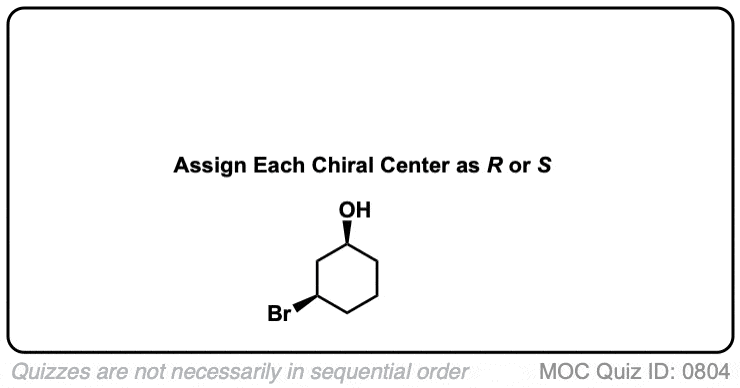 Click to Flip
Click to Flip
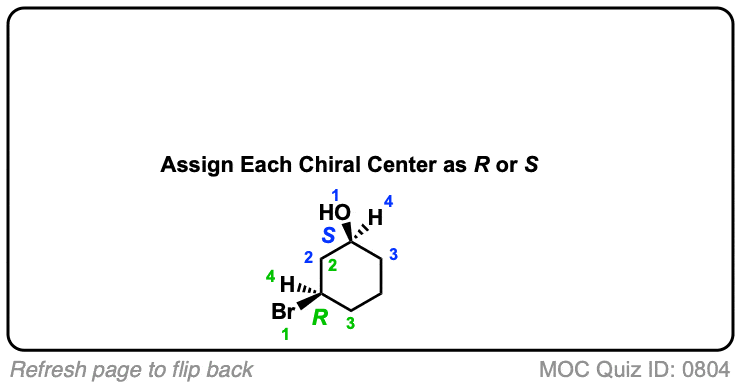
8. Assigning Cahn-Ingold-Prelog (CIP) Priorities With Multiple Bonds
The examples so far haven’t actually required any new concepts. However, the rules we’ve seen so far start breaking down once multiple bonds enter the picture.
For example it doesn’t make intuitive sense that a methyl group should be higher priority than an alkyne.

Clearly, a new rule is needed to deal with multiple bonds.
9. Expanding Out Multiple Bonds With “Phantom Atoms”
The solution is to “expand out” each multiple bond as a single bond attached to a “phantom atom” (in blue).

These “phantom atoms” are used solely for the purpose of determining CIP priority – they have no chemical meaning.
Note that in the process of assigning phantom atoms to both atoms in a multiple bond involves the more distant atom “looking backwards” toward the chiral centre. This is the only time that we are ever allowed to do this!
If we apply the “phantom atom” method to the multiple bonds in this molecule we then see that indeed the alkyne is higher priority than alkene, which is higher priority than ethyl.

If the process of assigning priorities to this molecule seemed unclear, hover here for a pop-up view or click on this link.
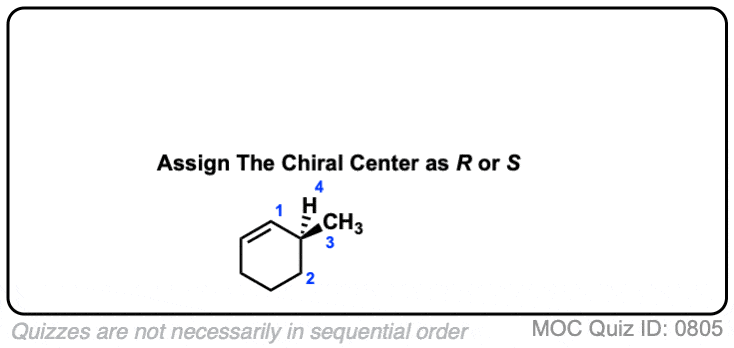 Click to Flip
Click to Flip
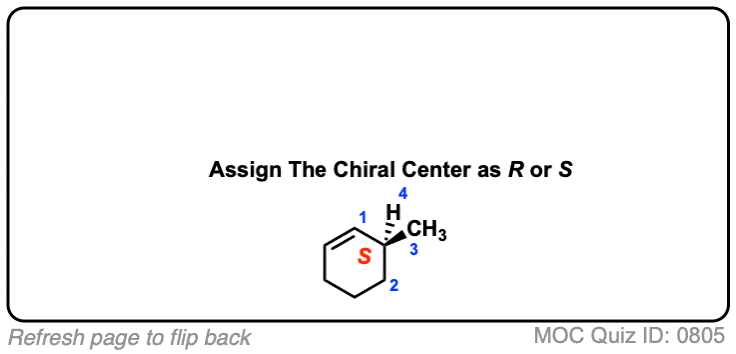
For a good time, try and use our new method to determine the priority of vinyl, isopropyl and s-butyl groups (below).
 Click to Flip
Click to Flip

The process is described rather densely here.
10. Cahn-Ingold-Prelog Priorities With Isotopes
Is there a point where we stop caring about differences? For example, let’s say we prepare a molecule with deuterium instead of hydrogen such as in the molecule below. Does that still count as a chiral centre?

Yes, this absolutely counts as a chiral centre. (Whether it would have a significant optical rotation is another story).
Assigning priority here is actually pretty straightforward. In cases where the atomic numbers are the same, we break ties by assigning highest priority to higher atomic weights.
For hydrogen, that means that tritium (3H) takes priority over deuterium (2H) which takes priority over protium (1H).

Granted, this is not the kind of situation you’d be likely to encounter in introductory organic. But it does come up! And by the way, preparing chiral molecules containing deuterium is not merely a theoretical exercise – it’s been hugely beneficial for determining the mechanism of action of enzymes.
 Click to Flip
Click to Flip

11. Conclusion: Assigning R/S Configurations With “The Method Of Dots”
For most cases, the “method of dots” will get you where you need to go to determine priorities for a chiral centre. The one key thing from this post to remember is the concept of “phantom atoms” for determining priorities in alkenes and other multiple bonds.
Anything missing that you want to talk about? Leave a comment!
Thanks again to Matt for helping with this post. Hire Matt as your tutor!
Notes
More quizzes for determining (R) and (S) can be found on the Stereochemistry Practice Quizzes page. (MOC Membership required for full access).
Related Articles
- Introduction to Assigning (R) and (S): The Cahn-Ingold-Prelog Rules
- The Single Swap Rule
- Assigning R/S To Newman Projections (And Converting Newman To Line Diagrams)
- How To Determine R and S Configurations On A Fischer Projection
- Chiral Allenes And Chiral Axes
Note 1. Here is a really interesting example of phantom atoms in action. Changing a group on nitrogen from H to CH3 results in a switch in configuration from (S) to (R). Big Hat Tip to r/dennisdcao
http://imgur.com/WLmmDNM
Note 2. This post also didn’t address the chirality present in allenes and other species with an axis of chirality. In those cases we don’t use R/S, we use P/M. The CIP priority rules still work though.
Note 3. Didn’t get into this, but… is the middle carbon here a chiral centre?

Not quite. That middle carbon is what’s known as a pseudo asymmetric centre. It does have 4 different substituents – the (R) chiral centre is different from (S). The IUPAC rule is that (R) takes priority over (S). The lower case letters (r) and (s) are used in this case. More on this topic here.
00 General Chemistry Review
01 Bonding, Structure, and Resonance
- How Do We Know Methane (CH4) Is Tetrahedral?
- Hybrid Orbitals and Hybridization
- How To Determine Hybridization: A Shortcut
- Orbital Hybridization And Bond Strengths
- Sigma bonds come in six varieties: Pi bonds come in one
- A Key Skill: How to Calculate Formal Charge
- The Four Intermolecular Forces and How They Affect Boiling Points
- 3 Trends That Affect Boiling Points
- How To Use Electronegativity To Determine Electron Density (and why NOT to trust formal charge)
- Introduction to Resonance
- How To Use Curved Arrows To Interchange Resonance Forms
- Evaluating Resonance Forms (1) - The Rule of Least Charges
- How To Find The Best Resonance Structure By Applying Electronegativity
- Evaluating Resonance Structures With Negative Charges
- Evaluating Resonance Structures With Positive Charge
- Exploring Resonance: Pi-Donation
- Exploring Resonance: Pi-acceptors
- In Summary: Evaluating Resonance Structures
- Drawing Resonance Structures: 3 Common Mistakes To Avoid
- How to apply electronegativity and resonance to understand reactivity
- Bond Hybridization Practice
- Structure and Bonding Practice Quizzes
- Resonance Structures Practice
02 Acid Base Reactions
- Introduction to Acid-Base Reactions
- Acid Base Reactions In Organic Chemistry
- The Stronger The Acid, The Weaker The Conjugate Base
- Walkthrough of Acid-Base Reactions (3) - Acidity Trends
- Five Key Factors That Influence Acidity
- Acid-Base Reactions: Introducing Ka and pKa
- How to Use a pKa Table
- The pKa Table Is Your Friend
- A Handy Rule of Thumb for Acid-Base Reactions
- Acid Base Reactions Are Fast
- pKa Values Span 60 Orders Of Magnitude
- How Protonation and Deprotonation Affect Reactivity
- Acid Base Practice Problems
03 Alkanes and Nomenclature
- Meet the (Most Important) Functional Groups
- Condensed Formulas: Deciphering What the Brackets Mean
- Hidden Hydrogens, Hidden Lone Pairs, Hidden Counterions
- Don't Be Futyl, Learn The Butyls
- Primary, Secondary, Tertiary, Quaternary In Organic Chemistry
- Branching, and Its Affect On Melting and Boiling Points
- The Many, Many Ways of Drawing Butane
- Wedge And Dash Convention For Tetrahedral Carbon
- Common Mistakes in Organic Chemistry: Pentavalent Carbon
- Table of Functional Group Priorities for Nomenclature
- Summary Sheet - Alkane Nomenclature
- Organic Chemistry IUPAC Nomenclature Demystified With A Simple Puzzle Piece Approach
- Boiling Point Quizzes
- Organic Chemistry Nomenclature Quizzes
04 Conformations and Cycloalkanes
- Staggered vs Eclipsed Conformations of Ethane
- Conformational Isomers of Propane
- Newman Projection of Butane (and Gauche Conformation)
- Introduction to Cycloalkanes
- Geometric Isomers In Small Rings: Cis And Trans Cycloalkanes
- Calculation of Ring Strain In Cycloalkanes
- Cycloalkanes - Ring Strain In Cyclopropane And Cyclobutane
- Cyclohexane Conformations
- Cyclohexane Chair Conformation: An Aerial Tour
- How To Draw The Cyclohexane Chair Conformation
- The Cyclohexane Chair Flip
- The Cyclohexane Chair Flip - Energy Diagram
- Substituted Cyclohexanes - Axial vs Equatorial
- Ranking The Bulkiness Of Substituents On Cyclohexanes: "A-Values"
- Cyclohexane Chair Conformation Stability: Which One Is Lower Energy?
- Fused Rings - Cis-Decalin and Trans-Decalin
- Naming Bicyclic Compounds - Fused, Bridged, and Spiro
- Bredt's Rule (And Summary of Cycloalkanes)
- Newman Projection Practice
- Cycloalkanes Practice Problems
05 A Primer On Organic Reactions
- The Most Important Question To Ask When Learning a New Reaction
- Curved Arrows (for reactions)
- Nucleophiles and Electrophiles
- The Three Classes of Nucleophiles
- Nucleophilicity vs. Basicity
- What Makes A Good Nucleophile?
- What Makes A Good Leaving Group?
- 3 Factors That Stabilize Carbocations
- Equilibrium and Energy Relationships
- 7 Factors that stabilize negative charge in organic chemistry
- 7 Factors That Stabilize Positive Charge in Organic Chemistry
- What's a Transition State?
- Hammond's Postulate
- Learning Organic Chemistry Reactions: A Checklist (PDF)
- Introduction to Oxidative Cleavage Reactions
06 Free Radical Reactions
- Free Radical Reactions
- 3 Factors That Stabilize Free Radicals
- Bond Strengths And Radical Stability
- Free Radical Initiation: Why Is "Light" Or "Heat" Required?
- Initiation, Propagation, Termination
- Monochlorination Products Of Propane, Pentane, And Other Alkanes
- Selectivity In Free Radical Reactions
- Selectivity in Free Radical Reactions: Bromination vs. Chlorination
- Halogenation At Tiffany's
- Allylic Bromination
- Bonus Topic: Allylic Rearrangements
- In Summary: Free Radicals
- Synthesis (2) - Reactions of Alkanes
- Free Radicals Practice Quizzes
07 Stereochemistry and Chirality
- Types of Isomers: Constitutional Isomers, Stereoisomers, Enantiomers, and Diastereomers
- How To Draw The Enantiomer Of A Chiral Molecule
- How To Draw A Bond Rotation
- Introduction to Assigning (R) and (S): The Cahn-Ingold-Prelog Rules
- Assigning Cahn-Ingold-Prelog (CIP) Priorities (2) - The Method of Dots
- Enantiomers vs Diastereomers vs The Same? Two Methods For Solving Problems
- Assigning R/S To Newman Projections (And Converting Newman To Line Diagrams)
- How To Determine R and S Configurations On A Fischer Projection
- The Meso Trap
- Optical Rotation, Optical Activity, and Specific Rotation
- Optical Purity and Enantiomeric Excess
- What's a Racemic Mixture?
- Chiral Allenes And Chiral Axes
- Stereochemistry Practice Problems and Quizzes
08 Substitution Reactions
- Nucleophilic Substitution Reactions - Introduction
- Two Types of Nucleophilic Substitution Reactions
- The SN2 Mechanism
- Why the SN2 Reaction Is Powerful
- The SN1 Mechanism
- The Conjugate Acid Is A Better Leaving Group
- Comparing the SN1 and SN2 Reactions
- Polar Protic? Polar Aprotic? Nonpolar? All About Solvents
- Steric Hindrance is Like a Fat Goalie
- Common Blind Spot: Intramolecular Reactions
- Substitution Practice - SN1
- Substitution Practice - SN2
09 Elimination Reactions
- Elimination Reactions (1): Introduction And The Key Pattern
- Elimination Reactions (2): The Zaitsev Rule
- Elimination Reactions Are Favored By Heat
- Two Elimination Reaction Patterns
- The E1 Reaction
- The E2 Mechanism
- E1 vs E2: Comparing the E1 and E2 Reactions
- Antiperiplanar Relationships: The E2 Reaction and Cyclohexane Rings
- Bulky Bases in Elimination Reactions
- Comparing the E1 vs SN1 Reactions
- Elimination (E1) Reactions With Rearrangements
- E1cB - Elimination (Unimolecular) Conjugate Base
- Elimination (E1) Practice Problems And Solutions
- Elimination (E2) Practice Problems and Solutions
10 Rearrangements
11 SN1/SN2/E1/E2 Decision
- Identifying Where Substitution and Elimination Reactions Happen
- Deciding SN1/SN2/E1/E2 (1) - The Substrate
- Deciding SN1/SN2/E1/E2 (2) - The Nucleophile/Base
- SN1 vs E1 and SN2 vs E2 : The Temperature
- Deciding SN1/SN2/E1/E2 - The Solvent
- Wrapup: The Key Factors For Determining SN1/SN2/E1/E2
- Alkyl Halide Reaction Map And Summary
- SN1 SN2 E1 E2 Practice Problems
12 Alkene Reactions
- E and Z Notation For Alkenes (+ Cis/Trans)
- Alkene Stability
- Alkene Addition Reactions: "Regioselectivity" and "Stereoselectivity" (Syn/Anti)
- Stereoselective and Stereospecific Reactions
- Hydrohalogenation of Alkenes and Markovnikov's Rule
- Hydration of Alkenes With Aqueous Acid
- Rearrangements in Alkene Addition Reactions
- Halogenation of Alkenes and Halohydrin Formation
- Oxymercuration Demercuration of Alkenes
- Hydroboration Oxidation of Alkenes
- m-CPBA (meta-chloroperoxybenzoic acid)
- OsO4 (Osmium Tetroxide) for Dihydroxylation of Alkenes
- Palladium on Carbon (Pd/C) for Catalytic Hydrogenation of Alkenes
- Cyclopropanation of Alkenes
- A Fourth Alkene Addition Pattern - Free Radical Addition
- Alkene Reactions: Ozonolysis
- Summary: Three Key Families Of Alkene Reaction Mechanisms
- Synthesis (4) - Alkene Reaction Map, Including Alkyl Halide Reactions
- Alkene Reactions Practice Problems
13 Alkyne Reactions
- Acetylides from Alkynes, And Substitution Reactions of Acetylides
- Partial Reduction of Alkynes With Lindlar's Catalyst
- Partial Reduction of Alkynes With Na/NH3 To Obtain Trans Alkenes
- Alkyne Hydroboration With "R2BH"
- Hydration and Oxymercuration of Alkynes
- Hydrohalogenation of Alkynes
- Alkyne Halogenation: Bromination and Chlorination of Alkynes
- Oxidation of Alkynes With O3 and KMnO4
- Alkenes To Alkynes Via Halogenation And Elimination Reactions
- Alkynes Are A Blank Canvas
- Synthesis (5) - Reactions of Alkynes
- Alkyne Reactions Practice Problems With Answers
14 Alcohols, Epoxides and Ethers
- Alcohols - Nomenclature and Properties
- Alcohols Can Act As Acids Or Bases (And Why It Matters)
- Alcohols - Acidity and Basicity
- The Williamson Ether Synthesis
- Ethers From Alkenes, Tertiary Alkyl Halides and Alkoxymercuration
- Alcohols To Ethers via Acid Catalysis
- Cleavage Of Ethers With Acid
- Epoxides - The Outlier Of The Ether Family
- Opening of Epoxides With Acid
- Epoxide Ring Opening With Base
- Making Alkyl Halides From Alcohols
- Tosylates And Mesylates
- PBr3 and SOCl2
- Elimination Reactions of Alcohols
- Elimination of Alcohols To Alkenes With POCl3
- Alcohol Oxidation: "Strong" and "Weak" Oxidants
- Demystifying The Mechanisms of Alcohol Oxidations
- Protecting Groups For Alcohols
- Thiols And Thioethers
- Calculating the oxidation state of a carbon
- Oxidation and Reduction in Organic Chemistry
- Oxidation Ladders
- SOCl2 Mechanism For Alcohols To Alkyl Halides: SN2 versus SNi
- Alcohol Reactions Roadmap (PDF)
- Alcohol Reaction Practice Problems
- Epoxide Reaction Quizzes
- Oxidation and Reduction Practice Quizzes
15 Organometallics
- What's An Organometallic?
- Formation of Grignard and Organolithium Reagents
- Organometallics Are Strong Bases
- Reactions of Grignard Reagents
- Protecting Groups In Grignard Reactions
- Synthesis Problems Involving Grignard Reagents
- Grignard Reactions And Synthesis (2)
- Organocuprates (Gilman Reagents): How They're Made
- Gilman Reagents (Organocuprates): What They're Used For
- The Heck, Suzuki, and Olefin Metathesis Reactions (And Why They Don't Belong In Most Introductory Organic Chemistry Courses)
- Reaction Map: Reactions of Organometallics
- Grignard Practice Problems
16 Spectroscopy
- Degrees of Unsaturation (or IHD, Index of Hydrogen Deficiency)
- Conjugation And Color (+ How Bleach Works)
- Introduction To UV-Vis Spectroscopy
- UV-Vis Spectroscopy: Absorbance of Carbonyls
- UV-Vis Spectroscopy: Practice Questions
- Bond Vibrations, Infrared Spectroscopy, and the "Ball and Spring" Model
- Infrared Spectroscopy: A Quick Primer On Interpreting Spectra
- IR Spectroscopy: 4 Practice Problems
- 1H NMR: How Many Signals?
- Homotopic, Enantiotopic, Diastereotopic
- Diastereotopic Protons in 1H NMR Spectroscopy: Examples
- 13-C NMR - How Many Signals
- Liquid Gold: Pheromones In Doe Urine
- Natural Product Isolation (1) - Extraction
- Natural Product Isolation (2) - Purification Techniques, An Overview
- Structure Determination Case Study: Deer Tarsal Gland Pheromone
17 Dienes and MO Theory
- What To Expect In Organic Chemistry 2
- Are these molecules conjugated?
- Conjugation And Resonance In Organic Chemistry
- Bonding And Antibonding Pi Orbitals
- Molecular Orbitals of The Allyl Cation, Allyl Radical, and Allyl Anion
- Pi Molecular Orbitals of Butadiene
- Reactions of Dienes: 1,2 and 1,4 Addition
- Thermodynamic and Kinetic Products
- More On 1,2 and 1,4 Additions To Dienes
- s-cis and s-trans
- The Diels-Alder Reaction
- Cyclic Dienes and Dienophiles in the Diels-Alder Reaction
- Stereochemistry of the Diels-Alder Reaction
- Exo vs Endo Products In The Diels Alder: How To Tell Them Apart
- HOMO and LUMO In the Diels Alder Reaction
- Why Are Endo vs Exo Products Favored in the Diels-Alder Reaction?
- Diels-Alder Reaction: Kinetic and Thermodynamic Control
- The Retro Diels-Alder Reaction
- The Intramolecular Diels Alder Reaction
- Regiochemistry In The Diels-Alder Reaction
- The Cope and Claisen Rearrangements
- Electrocyclic Reactions
- Electrocyclic Ring Opening And Closure (2) - Six (or Eight) Pi Electrons
- Diels Alder Practice Problems
- Molecular Orbital Theory Practice
18 Aromaticity
- Introduction To Aromaticity
- Rules For Aromaticity
- Huckel's Rule: What Does 4n+2 Mean?
- Aromatic, Non-Aromatic, or Antiaromatic? Some Practice Problems
- Antiaromatic Compounds and Antiaromaticity
- The Pi Molecular Orbitals of Benzene
- The Pi Molecular Orbitals of Cyclobutadiene
- Frost Circles
- Aromaticity Practice Quizzes
19 Reactions of Aromatic Molecules
- Electrophilic Aromatic Substitution: Introduction
- Activating and Deactivating Groups In Electrophilic Aromatic Substitution
- Electrophilic Aromatic Substitution - The Mechanism
- Ortho-, Para- and Meta- Directors in Electrophilic Aromatic Substitution
- Understanding Ortho, Para, and Meta Directors
- Why are halogens ortho- para- directors?
- Disubstituted Benzenes: The Strongest Electron-Donor "Wins"
- Electrophilic Aromatic Substitutions (1) - Halogenation of Benzene
- Electrophilic Aromatic Substitutions (2) - Nitration and Sulfonation
- EAS Reactions (3) - Friedel-Crafts Acylation and Friedel-Crafts Alkylation
- Intramolecular Friedel-Crafts Reactions
- Nucleophilic Aromatic Substitution (NAS)
- Nucleophilic Aromatic Substitution (2) - The Benzyne Mechanism
- Reactions on the "Benzylic" Carbon: Bromination And Oxidation
- The Wolff-Kishner, Clemmensen, And Other Carbonyl Reductions
- More Reactions on the Aromatic Sidechain: Reduction of Nitro Groups and the Baeyer Villiger
- Aromatic Synthesis (1) - "Order Of Operations"
- Synthesis of Benzene Derivatives (2) - Polarity Reversal
- Aromatic Synthesis (3) - Sulfonyl Blocking Groups
- Birch Reduction
- Synthesis (7): Reaction Map of Benzene and Related Aromatic Compounds
- Aromatic Reactions and Synthesis Practice
- Electrophilic Aromatic Substitution Practice Problems
20 Aldehydes and Ketones
- What's The Alpha Carbon In Carbonyl Compounds?
- Nucleophilic Addition To Carbonyls
- Aldehydes and Ketones: 14 Reactions With The Same Mechanism
- Sodium Borohydride (NaBH4) Reduction of Aldehydes and Ketones
- Grignard Reagents For Addition To Aldehydes and Ketones
- Wittig Reaction
- Hydrates, Hemiacetals, and Acetals
- Imines - Properties, Formation, Reactions, and Mechanisms
- All About Enamines
- Breaking Down Carbonyl Reaction Mechanisms: Reactions of Anionic Nucleophiles (Part 2)
- Aldehydes Ketones Reaction Practice
21 Carboxylic Acid Derivatives
- Nucleophilic Acyl Substitution (With Negatively Charged Nucleophiles)
- Addition-Elimination Mechanisms With Neutral Nucleophiles (Including Acid Catalysis)
- Basic Hydrolysis of Esters - Saponification
- Transesterification
- Proton Transfer
- Fischer Esterification - Carboxylic Acid to Ester Under Acidic Conditions
- Lithium Aluminum Hydride (LiAlH4) For Reduction of Carboxylic Acid Derivatives
- LiAlH[Ot-Bu]3 For The Reduction of Acid Halides To Aldehydes
- Di-isobutyl Aluminum Hydride (DIBAL) For The Partial Reduction of Esters and Nitriles
- Amide Hydrolysis
- Thionyl Chloride (SOCl2) And Conversion of Carboxylic Acids to Acid Halides
- Diazomethane (CH2N2)
- Carbonyl Chemistry: Learn Six Mechanisms For the Price Of One
- Making Music With Mechanisms (PADPED)
- Carboxylic Acid Derivatives Practice Questions
22 Enols and Enolates
- Keto-Enol Tautomerism
- Enolates - Formation, Stability, and Simple Reactions
- Kinetic Versus Thermodynamic Enolates
- Aldol Addition and Condensation Reactions
- Reactions of Enols - Acid-Catalyzed Aldol, Halogenation, and Mannich Reactions
- Claisen Condensation and Dieckmann Condensation
- Decarboxylation
- The Malonic Ester and Acetoacetic Ester Synthesis
- The Michael Addition Reaction and Conjugate Addition
- The Robinson Annulation
- Haloform Reaction
- The Hell–Volhard–Zelinsky Reaction
- Enols and Enolates Practice Quizzes
23 Amines
- The Amide Functional Group: Properties, Synthesis, and Nomenclature
- Basicity of Amines And pKaH
- 5 Key Basicity Trends of Amines
- The Mesomeric Effect And Aromatic Amines
- Nucleophilicity of Amines
- Alkylation of Amines (Sucks!)
- Reductive Amination
- The Gabriel Synthesis
- Some Reactions of Azides
- The Hofmann Elimination
- The Hofmann and Curtius Rearrangements
- The Cope Elimination
- Protecting Groups for Amines - Carbamates
- The Strecker Synthesis of Amino Acids
- Introduction to Peptide Synthesis
- Reactions of Diazonium Salts: Sandmeyer and Related Reactions
- Amine Practice Questions
24 Carbohydrates
- D and L Notation For Sugars
- Pyranoses and Furanoses: Ring-Chain Tautomerism In Sugars
- What is Mutarotation?
- Reducing Sugars
- The Big Damn Post Of Carbohydrate-Related Chemistry Definitions
- The Haworth Projection
- Converting a Fischer Projection To A Haworth (And Vice Versa)
- Reactions of Sugars: Glycosylation and Protection
- The Ruff Degradation and Kiliani-Fischer Synthesis
- Isoelectric Points of Amino Acids (and How To Calculate Them)
- Carbohydrates Practice
- Amino Acid Quizzes
25 Fun and Miscellaneous
- A Gallery of Some Interesting Molecules From Nature
- Screw Organic Chemistry, I'm Just Going To Write About Cats
- On Cats, Part 1: Conformations and Configurations
- On Cats, Part 2: Cat Line Diagrams
- On Cats, Part 4: Enantiocats
- On Cats, Part 6: Stereocenters
- Organic Chemistry Is Shit
- The Organic Chemistry Behind "The Pill"
- Maybe they should call them, "Formal Wins" ?
- Why Do Organic Chemists Use Kilocalories?
- The Principle of Least Effort
- Organic Chemistry GIFS - Resonance Forms
- Reproducibility In Organic Chemistry
- What Holds The Nucleus Together?
- How Reactions Are Like Music
- Organic Chemistry and the New MCAT
26 Organic Chemistry Tips and Tricks
- Common Mistakes: Formal Charges Can Mislead
- Partial Charges Give Clues About Electron Flow
- Draw The Ugly Version First
- Organic Chemistry Study Tips: Learn the Trends
- The 8 Types of Arrows In Organic Chemistry, Explained
- Top 10 Skills To Master Before An Organic Chemistry 2 Final
- Common Mistakes with Carbonyls: Carboxylic Acids... Are Acids!
- Planning Organic Synthesis With "Reaction Maps"
- Alkene Addition Pattern #1: The "Carbocation Pathway"
- Alkene Addition Pattern #2: The "Three-Membered Ring" Pathway
- Alkene Addition Pattern #3: The "Concerted" Pathway
- Number Your Carbons!
- The 4 Major Classes of Reactions in Org 1
- How (and why) electrons flow
- Grossman's Rule
- Three Exam Tips
- A 3-Step Method For Thinking Through Synthesis Problems
- Putting It Together
- Putting Diels-Alder Products in Perspective
- The Ups and Downs of Cyclohexanes
- The Most Annoying Exceptions in Org 1 (Part 1)
- The Most Annoying Exceptions in Org 1 (Part 2)
- The Marriage May Be Bad, But the Divorce Still Costs Money
- 9 Nomenclature Conventions To Know
- Nucleophile attacks Electrophile
27 Case Studies of Successful O-Chem Students
- Success Stories: How Corina Got The The "Hard" Professor - And Got An A+ Anyway
- How Helena Aced Organic Chemistry
- From a "Drop" To B+ in Org 2 – How A Hard Working Student Turned It Around
- How Serge Aced Organic Chemistry
- Success Stories: How Zach Aced Organic Chemistry 1
- Success Stories: How Kari Went From C– to B+
- How Esther Bounced Back From a "C" To Get A's In Organic Chemistry 1 And 2
- How Tyrell Got The Highest Grade In Her Organic Chemistry Course
- This Is Why Students Use Flashcards
- Success Stories: How Stu Aced Organic Chemistry
- How John Pulled Up His Organic Chemistry Exam Grades
- Success Stories: How Nathan Aced Organic Chemistry (Without It Taking Over His Life)
- How Chris Aced Org 1 and Org 2
- Interview: How Jay Got an A+ In Organic Chemistry
- How to Do Well in Organic Chemistry: One Student's Advice
- "America's Top TA" Shares His Secrets For Teaching O-Chem
- "Organic Chemistry Is Like..." - A Few Metaphors
- How To Do Well In Organic Chemistry: Advice From A Tutor
- Guest post: "I went from being afraid of tests to actually looking forward to them".
So what is the correct answer for the exercise under section 9? Is there a visual to show how the priorities can be assigned?
I got R as my answer, due to having to change the H position from planar to back view- is that correct?
Yes it is (R). The sec-butyl has the highest priority, followed by vinyl and isopropyl with H being last. I will write this up as a conventional quiz. Thanks for mentioning!
Very nicely explained sir. Thank you for sharing it .
Thank you sir but I have a doubt. How will we determine the priority order if there is no clear hierarchy. For eg if one group is —C=O and other is —CH—Cl
| |
OH CH3
Here if we add phantom atom
Then the carboxylic acid group becomes
O Cl
| |
C—O and C—H
| |
OH CH3
So here how do we get the first point of difference because if O and H are compared then the oxygen should get higher priority but if O and Cl are compared Cl should get higher priority
This was extremely helpful. Thanks!!
Thanks sir for your informative article.
One thing I wanted to know was the answer of the given exercise question because I think it’s not a chiral centre.
It’s definitely a chiral center.
Thank you for providing this concise summary of CIP priorities which cleared away my doubts and resparked my interest in truly understanding chemistry concepts instead of simply memorizing them. I wish you all the best in future endeavors!
Nice presentation!
Thank you masterorganicchemistry for giving me wonderful information about methods of dots
thanks a lot sir, your articles are very much helpful and the concept, knowledge that you provide is really outstanding
Thanks Baban.
Thanks a lot sir, this was really helpful.
I have a doubt though, In the problem with the multiple bonds, how do you assign the phantom atoms? I mean, are they C atoms? Are they N atoms? How is that decided?
For a C=C bond, the phantom atom is a C. For a C=N bond the phantom atom is N. For C=O the phantom atom is O. For a CN triple bond there are two phantom N atoms.
Does that answer your question?